Dysphagia Supplement Market
Dysphagia Supplement Market Size and Share Forecast Outlook 2025 to 2035
The dysphagia supplement market is projected to grow from USD 1,150.0 million in 2025 to USD 1,837.9 million by 2035, at a CAGR of 4.8%. Oral Nutritional Supplements will dominate with a 60.0% market share, while hospitals will lead the end user segment with a 50.0% share.
Dysphagia Supplement Market Forecast and Outlook 2025 to 2035
The dysphagia supplement market stands at the threshold of a decade-long expansion trajectory that promises to reshape nutritional therapy methodologies and swallowing disorder management solutions. The market's journey from USD 1,150.0 million in 2025 to USD 1,850.0 million by 2035 represents substantial growth, the market will rise at a CAGR of 4.8% which demonstrating the accelerating adoption of advanced nutritional formulas and therapeutic feeding optimization across healthcare facilities, home care operations, and specialized medical centers.
The first half of the decade (2025-2030) will witness the market climbing from USD 1,150.0 million to approximately USD 1,475.0 million, adding USD 325.0 million in value, which constitutes 46% of the total forecast growth period. This phase will be characterized by the rapid adoption of oral nutritional supplement systems, driven by increasing dysphagia diagnoses and the growing need for advanced therapeutic feeding solutions worldwide. Enhanced texture modification and automated preparation systems will become standard expectations rather than premium options.
The latter half (2030-2035) will witness continued growth from USD 1,475.0 million to USD 1,850.0 million, representing an addition of USD 375.0 million or 54% of the decade's expansion. This period will be defined by mass market penetration of enteral feeding technologies, integration with comprehensive nutritional management platforms, and seamless compatibility with existing healthcare infrastructure. The market trajectory signals fundamental shifts in how medical facilities approach dysphagia management and nutritional therapy, with participants positioned to benefit from growing demand across multiple product types and end-user segments.
Quick Stats for Dysphagia Supplement Market
- Dysphagia Supplement Market Value (2025): USD 1,150.0 million
- Dysphagia Supplement Market Forecast Value (2035): USD 1,850.0 million
- Dysphagia Supplement Market Forecast CAGR: 4.8%
- Leading Product Type in Dysphagia Supplement Market: Oral Nutritional Supplements
- Key Growth Regions in Dysphagia Supplement Market: North America, East Asia, and Western Europe
- Top Players in Dysphagia Supplement Market: Nestlé Health Science, Danone Nutricia, Abbott Nutrition, Fresenius Kabi, Hormel Health Labs
- Where revenue comes from - Now Vs Next (Industry-level view)
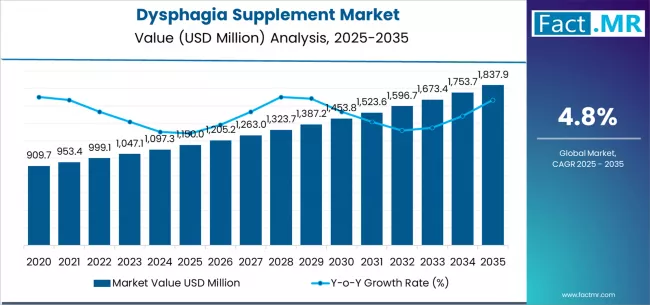
| Period | Primary Revenue Buckets | Share | Notes |
|---|---|---|---|
| Today | New supplement sales (oral, enteral formulas) | 55% | Volume-driven, prescription-based purchases |
| Preparation & texture modification services | 25% | Thickening agents, customized consistency | |
| Training & education programs | 12% | Feeding techniques, safety protocols | |
| Equipment & accessories | 8% | Feeding tools, preparation devices | |
| Future (3-5 yrs) | Advanced oral supplement systems | 45-50% | Enhanced palatability, improved nutrition density |
| Digital monitoring & compliance | 15-20% | Intake tracking, nutritional analytics | |
| Service-as-a-solution | 15-20% | Complete feeding programs, outcome guarantees | |
| Enteral formula innovations | 10-15% | Specialized formulations, custom preparations | |
| Training & certification | 8-12% | Advanced feeding techniques, safety compliance | |
| Data services (nutrition tracking, outcomes) | 5-8% | Performance metrics for healthcare providers |
Dysphagia Supplement Market Key Takeaways
At-a-Glance Metrics
| Metric | Value |
|---|---|
| Market Value (2025) → | USD 1,150.0 million |
| Market Forecast (2035) ↑ | USD 1,850.0 million |
| Growth Rate ★ | 4.8% CAGR |
| Leading Product → | Oral Nutritional Supplements |
| Primary End User → | Hospital Segment |
The market demonstrates strong fundamentals with oral nutritional supplements capturing a dominant share through advanced palatability and nutritional optimization capabilities. Hospital applications drive primary demand, supported by increasing swallowing disorder diagnoses and therapeutic feeding requirements. Geographic expansion remains concentrated in developed markets with established healthcare infrastructure, while emerging economies show accelerating adoption rates driven by medical facility modernization and rising clinical care standards.
Imperatives for Stakeholders in Dysphagia Supplement Market
Design for safety, not just nutrition
- Offer comprehensive feeding packages: supplements + preparation protocols + documentation + trained staff + clinical support.
- Preconfigured workflows: texture modification validation, feeding procedures, nutritional records, and digital tracking systems on patient outcomes.
Clinical integration readiness
- Real-time intake monitoring analytics, nutritional compliance capabilities, and advanced healthcare integration (electronic health records connectivity, patient tracking systems).
Quality-by-design approach
- Automated texture consistency systems, real-time aspiration prevention mechanisms, clinical outcome integration, and paperless nutritional documentation.
Value-based pricing models
- Clear base supplement price + transparent service tiers (clinical support, preparation guarantees, outcome tracking); subscriptions for digital services and analytics.
Segmental Analysis
The market by product type is segmented into oral nutritional supplements and enteral formulas, representing the evolution from traditional feeding solutions to specialized nutritional products for comprehensive dysphagia management optimization.
The end-user segmentation divides the market into hospitals, homecare, and nursing homes sectors, reflecting distinct requirements for clinical care, patient monitoring, and facility specialization standards.
Regional distribution covers North America, Latin America, Western Europe, Eastern Europe, East Asia, South Asia Pacific, and Middle East & Africa, with developed markets leading adoption while emerging economies show accelerating growth patterns driven by healthcare expansion programs.
The segmentation structure reveals product progression from standard nutritional solutions toward specialized feeding systems with enhanced safety and palatability capabilities, while end-user diversity spans from hospital facilities to home care operations requiring precise nutritional management solutions.
By Product Type, the Oral Nutritional Supplements Segment Accounts for Dominant Market Share
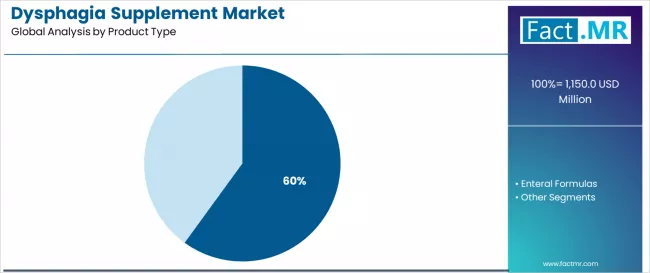
Oral nutritional supplements command the leading position in the dysphagia supplement market with 60.0% market share through advanced palatability features, including superior taste profiles, texture modification, and nutritional optimization that enable healthcare facilities to achieve optimal feeding outcomes across diverse dysphagia and clinical care environments.
The segment benefits from healthcare facility preference for reliable feeding solutions that provide consistent nutritional performance, reduced aspiration risks, and clinical efficiency optimization without requiring significant procedural modifications. Advanced formulation features enable automated texture systems, palatability consistency, and compatibility with existing healthcare equipment, where clinical performance and patient safety represent critical facility requirements.
Oral Nutritional Supplements differentiate through proven clinical reliability, consistent palatability characteristics, and integration with advanced healthcare systems that enhance facility effectiveness while maintaining optimal safety standards suitable for diverse dysphagia and clinical applications.
Key market characteristics:
- Advanced formulation designs with optimized texture configuration and nutritional efficiency capabilities
- Enhanced feeding effectiveness, enabling 96-98% patient acceptance with consistent nutritional performance
- Healthcare compatibility, including automated preparation systems, monitoring integration, and process optimization for feeding operations
Enteral Formulas Show Balanced Market Growth
Enteral formulas maintain a 40.0% market position in the dysphagia supplement market due to their specialized nutritional properties and clinical advantages. These formulas appeal to facilities requiring advanced feeding solutions with competitive efficacy for complex dysphagia applications. Market growth is driven by clinical expansion, emphasizing reliable nutritional solutions and therapeutic efficiency through optimized formula designs.
By End User, the Hospital Segment Shows Market Leadership
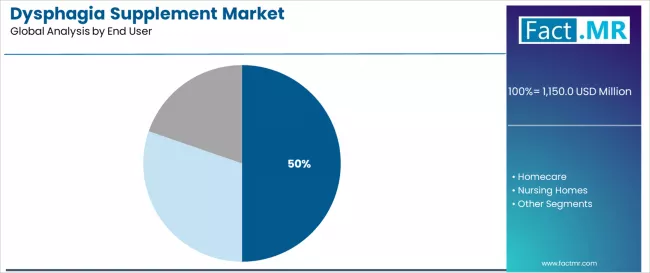
Hospital applications demonstrate the highest market share in the dysphagia supplement market with 50.0% dominance due to widespread adoption of clinical feeding systems and increasing focus on dysphagia management, patient outcomes, and facility specialization applications that maximize therapeutic success while maintaining quality standards.
Hospital operators prioritize product reliability, clinical integration, and compatibility with existing healthcare infrastructure that enables coordinated feeding operations across multiple patient care procedures. The segment benefits from substantial healthcare investment and modernization programs that emphasize the acquisition of advanced supplement products for therapeutic optimization and clinical excellence applications.
Hospital expansion programs incorporate dysphagia supplements as standard products for patient care operations, while specialized facility growth increases demand for reliable feeding capabilities that comply with clinical standards and minimize therapeutic complexity.
Application dynamics include:
- Strong growth in clinical procedures and dysphagia management requiring advanced nutritional capabilities
- Increasing adoption in therapeutic optimization and patient care applications for healthcare operators
- Rising integration with advanced clinical systems for operational optimization and outcome assurance
Homecare Applications Maintain Specialized Demand
Homecare applications capture 30.0% market share through specialized feeding requirements in home-based care, family management, and outpatient applications. These settings demand flexible nutritional products capable of operating with diverse patient conditions while providing effective feeding access and clinical reliability capabilities.
Nursing Homes Applications Show Care Leadership
Nursing Homes applications account for 20.0% market share, including long-term care operations, elderly patient management, and residential healthcare requiring consistent nutritional capabilities for care optimization and patient management.
What are the Drivers, Restraints, and Key Trends of the Dysphagia Supplement Market?
| Category | Factor | Impact | Why It Matters |
|---|---|---|---|
| Driver | Aging population & increased swallowing disorders (demographic trends, neurological conditions) | ★★★★★ | Growing elderly population experiences more dysphagia; creates consistent demand for specialized nutritional products with proven clinical safety across patient demographics. |
| Driver | Clinical safety & nutritional requirements (FDA, health authority standards) | ★★★★★ | Turns advanced supplement formulations from "optional" to "mandatory"; vendors that provide clinical validation and safety documentation gain competitive advantage. |
| Driver | Home healthcare expansion & discharge planning | ★★★★☆ | Patients need safe, easy-to-use products; demand for convenient preparation and reliable nutrition expanding addressable market opportunities. |
| Restraint | High product costs & insurance coverage limitations (especially for home patients) | ★★★★☆ | Patients and families face payment challenges; increases price sensitivity and slows advanced product adoption in home care markets. |
| Restraint | Complex preparation & texture modification requirements | ★★★☆☆ | Multi-patient facilities face lengthy preparation procedures and consistency requirements, limiting operational flexibility and increasing complexity. |
| Trend | Digital integration & nutritional tracking | ★★★★★ | Real-time intake monitoring, nutritional analytics, and patient outcome tracking transform care; connectivity and digital monitoring become core value propositions. |
| Trend | Personalized nutrition & custom formulations | ★★★★☆ | Flexible supplement products for individual needs; modular designs and custom preparation capabilities drive competition toward individualized solutions. |
Analysis of the Dysphagia Supplement Market by Key Country
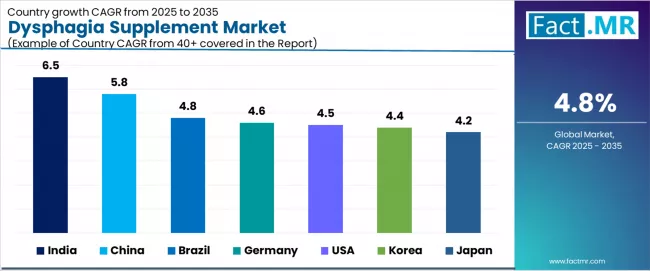
The dysphagia supplement market demonstrates varied regional dynamics with Growth Leaders including India (6.5% growth rate) and China (5.8% growth rate) driving expansion through healthcare facility development and medical capacity advancement. Steady Performers encompass Brazil (4.8% growth rate), Germany (4.6% growth rate), and United States (4.5% growth rate), benefiting from established healthcare industries and advanced medical adoption. Developed Markets feature Korea (4.4% growth rate) and Japan (4.2% growth rate), where healthcare infrastructure and clinical modernization support consistent growth patterns.
Regional synthesis reveals Asian markets leading adoption through healthcare expansion and medical development, while North American countries maintain steady expansion supported by medical technology advancement and regulatory standardization requirements. European markets show moderate growth driven by clinical applications and therapeutic integration trends.
| Region/Country | 2025-2035 Growth | How to win | What to watch out |
|---|---|---|---|
| India | 6.5% | Focus on cost-effective formulations | Regulatory changes; price competition |
| China | 5.8% | Lead with advanced nutritional solutions | Import requirements; clinical validation |
| Brazil | 4.8% | Provide clinical support | Currency fluctuations; reimbursement challenges |
| Germany | 4.6% | Offer premium quality products | Over-regulation; lengthy approval cycles |
| United States | 4.5% | Provide insurance support | Reimbursement complexity; cost pressures |
| Korea | 4.4% | Push digital integration | Technology adoption barriers; aging population |
| Japan | 4.2% | Focus on quality systems | Conservative adoption; demographic changes |
India Drives Fastest Market Growth
India establishes fastest market growth through aggressive healthcare facility programs and comprehensive medical capacity development, integrating advanced dysphagia supplement products as standard components in clinical nutrition and healthcare installations. The country's 6.5% growth rate reflects government initiatives promoting healthcare infrastructure and medical capabilities that mandate the use of advanced nutritional systems in hospital and specialized care facilities. Growth concentrates in major medical hubs, including Delhi, Mumbai, and Chennai, where healthcare technology development showcases integrated nutritional systems that appeal to medical operators seeking advanced therapeutic optimization capabilities and patient care applications.
Indian manufacturers are developing cost-effective supplement solutions that combine domestic production advantages with advanced nutritional features, including automated preparation systems and enhanced palatability capabilities. Distribution channels through medical equipment suppliers and healthcare service distributors expand market access, while government support for healthcare infrastructure supports adoption across diverse clinical and patient care segments.
Strategic Market Indicators:
- Healthcare facilities leading adoption with 75% deployment rate in clinical nutrition and dysphagia management sectors
- Government healthcare programs providing substantial funding for domestic medical technology development
- Local manufacturers capturing 45% market share through competitive pricing and localized clinical support
- Export market development for cost-effective supplement solutions targeting emerging healthcare markets
China Emerges as High-Growth Market
In Beijing, Shanghai, and Guangzhou, healthcare facilities and medical centers are implementing advanced dysphagia supplement products as standard components for clinical optimization and therapeutic compliance applications, driven by increasing government medical investment and healthcare modernization programs that emphasize the importance of nutritional capabilities. The market holds a 5.8% growth rate, supported by government healthcare initiatives and medical infrastructure development programs that promote advanced supplement systems for clinical and specialized care facilities. Chinese operators are adopting supplement products that provide consistent therapeutic performance and clinical compliance features, particularly appealing in urban regions where patient care efficiency and clinical standards represent critical operational requirements.
Market expansion benefits from growing healthcare capabilities and international technology transfer agreements that enable domestic production of advanced supplement systems for clinical and medical applications. Technology adoption follows patterns established in medical equipment, where reliability and performance drive procurement decisions and clinical deployment.
Market Intelligence Brief:
- Clinical and specialized care segments are driving initial adoption with 48% annual growth in product procurement
- Healthcare modernization programs emphasizing supplement products for therapeutic efficiency and clinical compliance
- Local manufacturers partnering with international providers for system development
- Medical facilities implementing supplement products for clinical optimization and patient care management
Brazil Shows Strong Regional Leadership
Brazil's market expansion benefits from diverse healthcare demand, including medical modernization in São Paulo and Rio de Janeiro, healthcare facility upgrades, and government medical programs that increasingly incorporate supplement solutions for clinical optimization applications. The country maintains a 4.8% growth rate, driven by rising healthcare activity and increasing recognition of supplement product benefits, including precise nutritional control and enhanced therapeutic efficiency.
Market dynamics focus on cost-effective supplement solutions that balance advanced clinical performance with affordability considerations important to Brazilian healthcare operators. Growing medical industrialization creates continued demand for modern supplement products in new facility infrastructure and healthcare modernization projects.
Strategic Market Considerations:
- Clinical and specialized care segments leading growth with focus on therapeutic optimization and patient care applications
- Regional healthcare requirements driving a diverse product portfolio from basic supplement products to advanced systems
- Import dependency challenges offset by potential local production partnerships with international manufacturers
- Government healthcare initiatives beginning to influence procurement standards and clinical requirements
Germany Shows Technology Leadership
Germany's advanced medical technology market demonstrates sophisticated dysphagia supplement product deployment with documented clinical effectiveness in healthcare applications and medical facilities through integration with existing quality systems and medical infrastructure. The country leverages engineering expertise in medical technology and quality systems integration to maintain a 4.6% growth rate. Industrial centers, including Baden-Württemberg, Bavaria, and North Rhine-Westphalia, showcase premium installations where supplement products integrate with comprehensive medical platforms and facility management systems to optimize clinical operations and therapeutic effectiveness.
German manufacturers prioritize product precision and EU compliance in supplement development, creating demand for premium products with advanced features, including facility monitoring integration and automated quality systems. The market benefits from established medical technology infrastructure and a willingness to invest in advanced healthcare technologies that provide long-term clinical benefits and compliance with international medical standards.
Market Intelligence Brief:
- Engineering focuses on EU standardization and clinical compliance, driving premium segment growth
- Medical technology partnerships providing 32% faster development cycles
- Technology collaboration between German manufacturers and international medical companies
- Facility training programs expanding supplement product integration in clinical scenarios
United States Maintains Market Leadership
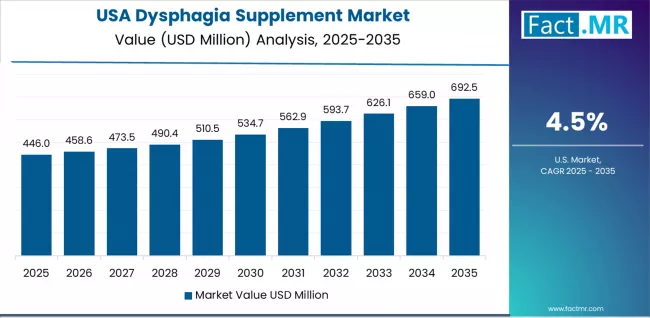
United States establishes market leadership through comprehensive healthcare programs and advanced medical infrastructure development, integrating dysphagia supplement products across clinical and specialized medical applications. The country's 4.5% growth rate reflects established healthcare industry relationships and mature supplement technology adoption that supports widespread use of precision supplement products in hospital and medical facilities. Growth concentrates in major medical centers, including California, Texas, and New York, where medical technology showcases mature supplement deployment that appeals to medical operators seeking proven precision supplement capabilities and clinical efficiency applications.
American product providers leverage established distribution networks and comprehensive service capabilities, including clinical validation programs and support services that create customer relationships and operational advantages. The market benefits from mature regulatory standards and medical requirements that mandate supplement product use while supporting technology advancement and clinical optimization.
Market Intelligence Brief:
- Healthcare and medical facilities maintaining 82% adoption rate with mature supplement deployment
- Established regulatory standards providing consistent demand for supplement technology advancement
- Specialized medical networks capturing 65% market share through clinical flexibility and outcome efficiency
- Technology integration programs expanding supplement capabilities in healthcare scenarios
Korea Shows Digital Integration Focus
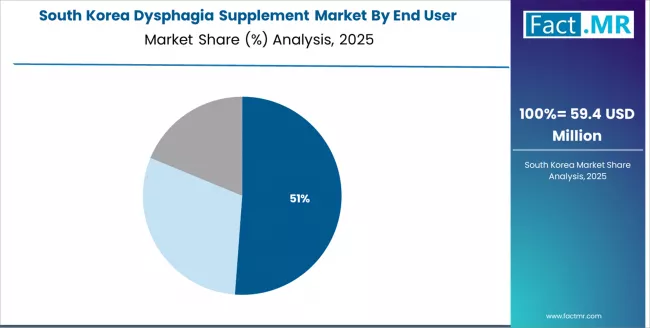
Korea's advanced medical technology market demonstrates sophisticated dysphagia supplement product deployment with comprehensive digital integration and outcome monitoring capabilities. The country maintains a 4.4% growth rate through advanced medical infrastructure and technology adoption programs. Medical centers in Seoul, Busan, and Incheon showcase integrated installations where supplement products connect with comprehensive medical platforms and digital outcome systems to optimize clinical effectiveness and therapeutic performance.
Korean medical facilities prioritize digital integration and outcome analytics in supplement product adoption, creating demand for connected products with advanced monitoring capabilities. The market benefits from government medical technology investment and healthcare modernization initiatives that promote digital health solutions.
Market Intelligence Brief:
- Digital integration driving 42% of new supplement product adoptions with outcome monitoring capabilities
- Government healthcare digitization programs providing infrastructure support
- Medical technology partnerships expanding digital capabilities in clinical applications
- Healthcare training programs emphasizing digital integration and outcome analytics
Japan Shows Quality Leadership
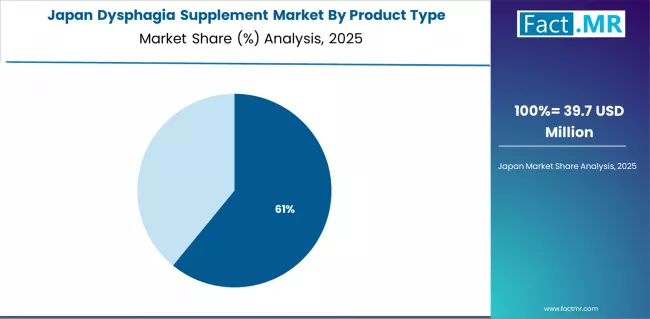
Japan maintains a 4.2% growth rate through established medical technology infrastructure and comprehensive quality management programs. The country's medical facilities demonstrate sophisticated supplement product integration with emphasis on clinical outcomes and quality assurance across healthcare and specialized medical applications.
Japanese medical operators prioritize product reliability and clinical consistency in supplement adoption, while established quality standards and medical requirements create continued demand for advanced supplement products with proven clinical effectiveness.
Market Intelligence Brief:
- Quality-focused adoption with 85% emphasis on clinical outcomes and product reliability
- Established medical technology infrastructure supporting advanced supplement product integration
- Medical facility modernization programs expanding supplement capabilities
- Clinical excellence initiatives driving demand for premium supplement products
Europe Market Split by Country
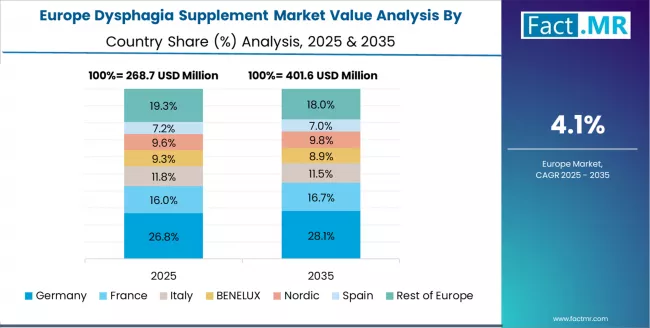
The European dysphagia supplement market is projected to grow from USD 900.0 million in 2025 to USD 1,470.0 million by 2035, registering a CAGR of 5.0% over the forecast period. Germany is expected to maintain its leadership position with a 21.1% market share in 2025, supported by advanced healthcare technology infrastructure and major medical centers.
France follows with a 16.7% share in 2025, driven by comprehensive healthcare programs and medical technology development initiatives. The United Kingdom holds a 15.6% share through specialized clinical applications and therapeutic compliance requirements. Italy commands a 13.3% share, while Spain accounts for 11.1% in 2025. The Rest of Europe region represents a 22.2% share, attributed to increasing healthcare adoption in Nordic countries and emerging medical facilities implementing healthcare modernization programs.
By 2035, the market is expected to maintain a similar distribution, with Germany and the Rest of Europe retaining leading positions while mid-tier markets see gradual growth as therapeutic adoption expands.
Competitive Landscape of the Dysphagia Supplement Market
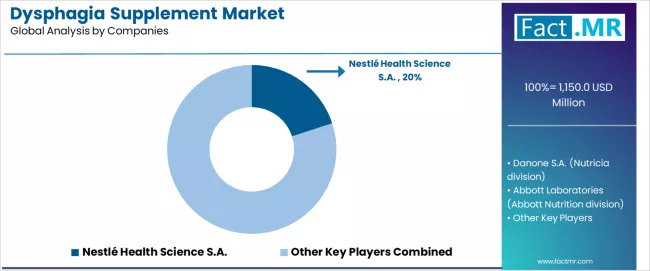
- Structure: 12-18 credible players; top 3-5 hold 55-60% by revenue.
- Leadership is maintained through: clinical validation networks, nutritional expertise, and product innovation (palatability + safety + nutritional density).
- What's commoditizing: basic supplement formulations and standard texture modification processes.
- Margin Opportunities: clinical validation services, outcome tracking, and integration into healthcare workflows (EHR/clinical systems, digital nutritional records).
| Stakeholder | What they actually control | Typical strengths | Typical blind spots |
|---|---|---|---|
| Global platforms | Distribution reach, deep product portfolios, service networks | Broad availability, proven reliability, multi-region support | Technology refresh cycles; customer dependency |
| Technology innovators | R&D capabilities; advanced formulations; clean digital interfaces | Latest features first; attractive ROI on high-volume applications | Service density outside core regions; customization complexity |
| Regional specialists | Local compliance, fast delivery, nearby clinical support | "Close to facility" support; pragmatic pricing; local regulations | Technology gaps; talent retention in clinical services |
| Service-focused ecosystems | Clinical validation support, outcome tracking, product availability | Lowest real complications; comprehensive clinical support | Service costs if overpromised; product obsolescence |
| Niche specialists | Specialized applications, custom solutions, R&D support | Win research/development applications; flexible configurations | Scalability limitations; narrow market focus |
Key Players in the Dysphagia Supplement Market
- Nestlé Health Science S.A.
- Danone S.A. (Nutricia division)
- Abbott Laboratories (Abbott Nutrition division)
- Fresenius Kabi AG
- Hormel Health Labs Inc.
- Medline Industries, LP (Nutrition division)
- Reckitt Benckiser Group plc (Mead Johnson Nutrition division)
- Arla Foods Ingredients Group P/S
- Apetito AG
- Meiji Holdings Co. Ltd.
- Wakodo Co. Ltd.
- Nualtra Limited
- Flavour Creations Pty Ltd.
- TastiPure LLC
- NutriThick LLC
Scope of the Report
| Items | Values |
|---|---|
| Quantitative Units (2025) | USD 1,150.0 million |
| Product Type | Oral Nutritional Supplements, Enteral Formulas |
| End User | Hospitals, Homecare, Nursing Homes |
| Regions Covered | North America, Latin America, Western Europe, Eastern Europe, East Asia, South Asia Pacific, Middle East & Africa |
| Countries Covered | United States, China, Germany, India, United Kingdom, Japan, Canada, Brazil, France, Australia, Korea, and 25+ additional countries |
| Key Companies Profiled | Nestlé Health Science, Danone Nutricia, Abbott Nutrition, Fresenius Kabi, Hormel Health Labs, Medline Nutrition, Mead Johnson, Arla Foods Ingredients, Apetito, Meiji Holdings, Wakodo, Nualtra, Flavour Creations, TastiPure, NutriThick |
| Additional Attributes | Dollar sales by product type and end-user categories, regional adoption trends across North America, East Asia, and Western Europe, competitive landscape with nutritional product manufacturers and healthcare suppliers, healthcare operator preferences for nutritional safety control and product reliability, integration with healthcare platforms and outcome monitoring systems, innovations in supplement technology and nutritional enhancement, and development of advanced supplement solutions with enhanced performance and dysphagia management optimization capabilities. |
Dysphagia Supplement Market by Segments
-
Product Type :
- Oral Nutritional Supplements
- Enteral Formulas
-
End User :
- Hospitals
- Homecare
- Nursing Homes
-
Region :
- North America
- United States
- Canada
- Mexico
- Latin America
- Brazil
- Chile
- Rest of Latin America
- Western Europe
- Germany
- United Kingdom
- France
- Italy
- Spain
- Nordic
- BENELUX
- Rest of Western Europe
- Eastern Europe
- Russia
- Poland
- Rest of Eastern Europe
- East Asia
- China
- Japan
- South Korea
- South Asia Pacific
- India
- ASEAN
- Australia & New Zealand
- Rest of South Asia Pacific
- Middle East & Africa
- Kingdom of Saudi Arabia
- Other GCC Countries
- Turkey
- South Africa
- Other African Union
- Rest of Middle East & Africa
- North America
Table of Content
- Executive Summary
- Global Market Outlook
- Demand to side Trends
- Supply to side Trends
- Technology Roadmap Analysis
- Analysis and Recommendations
- Market Overview
- Market Coverage / Taxonomy
- Market Definition / Scope / Limitations
- Market Background
- Market Dynamics
- Drivers
- Restraints
- Opportunity
- Trends
- Scenario Forecast
- Demand in Optimistic Scenario
- Demand in Likely Scenario
- Demand in Conservative Scenario
- Opportunity Map Analysis
- Product Life Cycle Analysis
- Supply Chain Analysis
- Investment Feasibility Matrix
- Value Chain Analysis
- PESTLE and Porter’s Analysis
- Regulatory Landscape
- Regional Parent Market Outlook
- Production and Consumption Statistics
- Import and Export Statistics
- Market Dynamics
- Global Market Analysis 2020 to 2024 and Forecast, 2025 to 2035
- Historical Market Size Value (USD Million) Analysis, 2020 to 2024
- Current and Future Market Size Value (USD Million) Projections, 2025 to 2035
- Y to o to Y Growth Trend Analysis
- Absolute $ Opportunity Analysis
- Global Market Pricing Analysis 2020 to 2024 and Forecast 2025 to 2035
- Global Market Analysis 2020 to 2024 and Forecast 2025 to 2035, By Product Type
- Introduction / Key Findings
- Historical Market Size Value (USD Million) Analysis By Product Type , 2020 to 2024
- Current and Future Market Size Value (USD Million) Analysis and Forecast By Product Type , 2025 to 2035
- Oral Nutritional Supplements
- Enteral Formulas
- Y to o to Y Growth Trend Analysis By Product Type , 2020 to 2024
- Absolute $ Opportunity Analysis By Product Type , 2025 to 2035
- Global Market Analysis 2020 to 2024 and Forecast 2025 to 2035, By End User
- Introduction / Key Findings
- Historical Market Size Value (USD Million) Analysis By End User, 2020 to 2024
- Current and Future Market Size Value (USD Million) Analysis and Forecast By End User, 2025 to 2035
- Hospitals
- Homecare
- Nursing Homes
- Y to o to Y Growth Trend Analysis By End User, 2020 to 2024
- Absolute $ Opportunity Analysis By End User, 2025 to 2035
- Global Market Analysis 2020 to 2024 and Forecast 2025 to 2035, By Region
- Introduction
- Historical Market Size Value (USD Million) Analysis By Region, 2020 to 2024
- Current Market Size Value (USD Million) Analysis and Forecast By Region, 2025 to 2035
- North America
- Latin America
- Western Europe
- Eastern Europe
- East Asia
- South Asia and Pacific
- Middle East & Africa
- Market Attractiveness Analysis By Region
- North America Market Analysis 2020 to 2024 and Forecast 2025 to 2035, By Country
- Historical Market Size Value (USD Million) Trend Analysis By Market Taxonomy, 2020 to 2024
- Market Size Value (USD Million) Forecast By Market Taxonomy, 2025 to 2035
- By Country
- USA
- Canada
- Mexico
- By Product Type
- By End User
- By Country
- Market Attractiveness Analysis
- By Country
- By Product Type
- By End User
- Key Takeaways
- Latin America Market Analysis 2020 to 2024 and Forecast 2025 to 2035, By Country
- Historical Market Size Value (USD Million) Trend Analysis By Market Taxonomy, 2020 to 2024
- Market Size Value (USD Million) Forecast By Market Taxonomy, 2025 to 2035
- By Country
- Brazil
- Chile
- Rest of Latin America
- By Product Type
- By End User
- By Country
- Market Attractiveness Analysis
- By Country
- By Product Type
- By End User
- Key Takeaways
- Western Europe Market Analysis 2020 to 2024 and Forecast 2025 to 2035, By Country
- Historical Market Size Value (USD Million) Trend Analysis By Market Taxonomy, 2020 to 2024
- Market Size Value (USD Million) Forecast By Market Taxonomy, 2025 to 2035
- By Country
- Germany
- UK
- Italy
- Spain
- France
- Nordic
- BENELUX
- Rest of Western Europe
- By Product Type
- By End User
- By Country
- Market Attractiveness Analysis
- By Country
- By Product Type
- By End User
- Key Takeaways
- Eastern Europe Market Analysis 2020 to 2024 and Forecast 2025 to 2035, By Country
- Historical Market Size Value (USD Million) Trend Analysis By Market Taxonomy, 2020 to 2024
- Market Size Value (USD Million) Forecast By Market Taxonomy, 2025 to 2035
- By Country
- Russia
- Poland
- Hungary
- Balkan & Baltic
- Rest of Eastern Europe
- By Product Type
- By End User
- By Country
- Market Attractiveness Analysis
- By Country
- By Product Type
- By End User
- Key Takeaways
- East Asia Market Analysis 2020 to 2024 and Forecast 2025 to 2035, By Country
- Historical Market Size Value (USD Million) Trend Analysis By Market Taxonomy, 2020 to 2024
- Market Size Value (USD Million) Forecast By Market Taxonomy, 2025 to 2035
- By Country
- China
- Japan
- South Korea
- By Product Type
- By End User
- By Country
- Market Attractiveness Analysis
- By Country
- By Product Type
- By End User
- Key Takeaways
- South Asia and Pacific Market Analysis 2020 to 2024 and Forecast 2025 to 2035, By Country
- Historical Market Size Value (USD Million) Trend Analysis By Market Taxonomy, 2020 to 2024
- Market Size Value (USD Million) Forecast By Market Taxonomy, 2025 to 2035
- By Country
- India
- ASEAN
- Australia & New Zealand
- Rest of South Asia and Pacific
- By Product Type
- By End User
- By Country
- Market Attractiveness Analysis
- By Country
- By Product Type
- By End User
- Key Takeaways
- Middle East & Africa Market Analysis 2020 to 2024 and Forecast 2025 to 2035, By Country
- Historical Market Size Value (USD Million) Trend Analysis By Market Taxonomy, 2020 to 2024
- Market Size Value (USD Million) Forecast By Market Taxonomy, 2025 to 2035
- By Country
- Kingdom of Saudi Arabia
- Other GCC Countries
- Turkiye
- South Africa
- Other African Union
- Rest of Middle East & Africa
- By Product Type
- By End User
- By Country
- Market Attractiveness Analysis
- By Country
- By Product Type
- By End User
- Key Takeaways
- Key Countries Market Analysis
- USA
- Pricing Analysis
- Market Share Analysis, 2024
- By Product Type
- By End User
- Canada
- Pricing Analysis
- Market Share Analysis, 2024
- By Product Type
- By End User
- Mexico
- Pricing Analysis
- Market Share Analysis, 2024
- By Product Type
- By End User
- Brazil
- Pricing Analysis
- Market Share Analysis, 2024
- By Product Type
- By End User
- Chile
- Pricing Analysis
- Market Share Analysis, 2024
- By Product Type
- By End User
- Germany
- Pricing Analysis
- Market Share Analysis, 2024
- By Product Type
- By End User
- UK
- Pricing Analysis
- Market Share Analysis, 2024
- By Product Type
- By End User
- Italy
- Pricing Analysis
- Market Share Analysis, 2024
- By Product Type
- By End User
- Spain
- Pricing Analysis
- Market Share Analysis, 2024
- By Product Type
- By End User
- France
- Pricing Analysis
- Market Share Analysis, 2024
- By Product Type
- By End User
- India
- Pricing Analysis
- Market Share Analysis, 2024
- By Product Type
- By End User
- ASEAN
- Pricing Analysis
- Market Share Analysis, 2024
- By Product Type
- By End User
- Australia & New Zealand
- Pricing Analysis
- Market Share Analysis, 2024
- By Product Type
- By End User
- China
- Pricing Analysis
- Market Share Analysis, 2024
- By Product Type
- By End User
- Japan
- Pricing Analysis
- Market Share Analysis, 2024
- By Product Type
- By End User
- South Korea
- Pricing Analysis
- Market Share Analysis, 2024
- By Product Type
- By End User
- Russia
- Pricing Analysis
- Market Share Analysis, 2024
- By Product Type
- By End User
- Poland
- Pricing Analysis
- Market Share Analysis, 2024
- By Product Type
- By End User
- Hungary
- Pricing Analysis
- Market Share Analysis, 2024
- By Product Type
- By End User
- Kingdom of Saudi Arabia
- Pricing Analysis
- Market Share Analysis, 2024
- By Product Type
- By End User
- Turkiye
- Pricing Analysis
- Market Share Analysis, 2024
- By Product Type
- By End User
- South Africa
- Pricing Analysis
- Market Share Analysis, 2024
- By Product Type
- By End User
- USA
- Market Structure Analysis
- Competition Dashboard
- Competition Benchmarking
- Market Share Analysis of Top Players
- By Regional
- By Product Type
- By End User
- Competition Analysis
- Competition Deep Dive
- Nestlé Health Science S.A.
- Overview
- Product Portfolio
- Profitability by Market Segments (Product/Age /Sales Channel/Region)
- Sales Footprint
- Strategy Overview
- Marketing Strategy
- Product Strategy
- Channel Strategy
- Danone S.A. (Nutricia division)
- Abbott Laboratories (Abbott Nutrition division)
- Fresenius Kabi AG
- Hormel Health Labs, Inc.
- Medline Industries, LP (Nutrition division)
- Reckitt Benckiser Group plc (Mead Johnson Nutrition division)
- Arla Foods Ingredients Group P/S
- Apetito AG
- Meiji Holdings Co., Ltd.
- Wakodo Co., Ltd.
- Nualtra Limited
- Flavour Creations Pty Ltd.
- TastiPure, LLC
- NutriThick, LLC
- Nestlé Health Science S.A.
- Competition Deep Dive
- Assumptions & Acronyms Used
- Research Methodology
List Of Table
- Table 1: Global Market Value (USD Million) Forecast by Region, 2020 to 2035
- Table 2: Global Market Value (USD Million) Forecast by Product Type , 2020 to 2035
- Table 3: Global Market Value (USD Million) Forecast by End User, 2020 to 2035
- Table 4: North America Market Value (USD Million) Forecast by Country, 2020 to 2035
- Table 5: North America Market Value (USD Million) Forecast by Product Type , 2020 to 2035
- Table 6: North America Market Value (USD Million) Forecast by End User, 2020 to 2035
- Table 7: Latin America Market Value (USD Million) Forecast by Country, 2020 to 2035
- Table 8: Latin America Market Value (USD Million) Forecast by Product Type , 2020 to 2035
- Table 9: Latin America Market Value (USD Million) Forecast by End User, 2020 to 2035
- Table 10: Western Europe Market Value (USD Million) Forecast by Country, 2020 to 2035
- Table 11: Western Europe Market Value (USD Million) Forecast by Product Type , 2020 to 2035
- Table 12: Western Europe Market Value (USD Million) Forecast by End User, 2020 to 2035
- Table 13: Eastern Europe Market Value (USD Million) Forecast by Country, 2020 to 2035
- Table 14: Eastern Europe Market Value (USD Million) Forecast by Product Type , 2020 to 2035
- Table 15: Eastern Europe Market Value (USD Million) Forecast by End User, 2020 to 2035
- Table 16: East Asia Market Value (USD Million) Forecast by Country, 2020 to 2035
- Table 17: East Asia Market Value (USD Million) Forecast by Product Type , 2020 to 2035
- Table 18: East Asia Market Value (USD Million) Forecast by End User, 2020 to 2035
- Table 19: South Asia and Pacific Market Value (USD Million) Forecast by Country, 2020 to 2035
- Table 20: South Asia and Pacific Market Value (USD Million) Forecast by Product Type , 2020 to 2035
- Table 21: South Asia and Pacific Market Value (USD Million) Forecast by End User, 2020 to 2035
- Table 22: Middle East & Africa Market Value (USD Million) Forecast by Country, 2020 to 2035
- Table 23: Middle East & Africa Market Value (USD Million) Forecast by Product Type , 2020 to 2035
- Table 24: Middle East & Africa Market Value (USD Million) Forecast by End User, 2020 to 2035
List Of Figures
- Figure 1: Global Market Pricing Analysis
- Figure 2: Global Market Value (USD Million) Forecast 2020-2035
- Figure 3: Global Market Value Share and BPS Analysis by Product Type , 2025 and 2035
- Figure 4: Global Market Y to o to Y Growth Comparison by Product Type , 2025-2035
- Figure 5: Global Market Attractiveness Analysis by Product Type
- Figure 6: Global Market Value Share and BPS Analysis by End User, 2025 and 2035
- Figure 7: Global Market Y to o to Y Growth Comparison by End User, 2025-2035
- Figure 8: Global Market Attractiveness Analysis by End User
- Figure 9: Global Market Value (USD Million) Share and BPS Analysis by Region, 2025 and 2035
- Figure 10: Global Market Y to o to Y Growth Comparison by Region, 2025-2035
- Figure 11: Global Market Attractiveness Analysis by Region
- Figure 12: North America Market Incremental Dollar Opportunity, 2025-2035
- Figure 13: Latin America Market Incremental Dollar Opportunity, 2025-2035
- Figure 14: Western Europe Market Incremental Dollar Opportunity, 2025-2035
- Figure 15: Eastern Europe Market Incremental Dollar Opportunity, 2025-2035
- Figure 16: East Asia Market Incremental Dollar Opportunity, 2025-2035
- Figure 17: South Asia and Pacific Market Incremental Dollar Opportunity, 2025-2035
- Figure 18: Middle East & Africa Market Incremental Dollar Opportunity, 2025-2035
- Figure 19: North America Market Value Share and BPS Analysis by Country, 2025 and 2035
- Figure 20: North America Market Value Share and BPS Analysis by Product Type , 2025 and 2035
- Figure 21: North America Market Y to o to Y Growth Comparison by Product Type , 2025-2035
- Figure 22: North America Market Attractiveness Analysis by Product Type
- Figure 23: North America Market Value Share and BPS Analysis by End User, 2025 and 2035
- Figure 24: North America Market Y to o to Y Growth Comparison by End User, 2025-2035
- Figure 25: North America Market Attractiveness Analysis by End User
- Figure 26: Latin America Market Value Share and BPS Analysis by Country, 2025 and 2035
- Figure 27: Latin America Market Value Share and BPS Analysis by Product Type , 2025 and 2035
- Figure 28: Latin America Market Y to o to Y Growth Comparison by Product Type , 2025-2035
- Figure 29: Latin America Market Attractiveness Analysis by Product Type
- Figure 30: Latin America Market Value Share and BPS Analysis by End User, 2025 and 2035
- Figure 31: Latin America Market Y to o to Y Growth Comparison by End User, 2025-2035
- Figure 32: Latin America Market Attractiveness Analysis by End User
- Figure 33: Western Europe Market Value Share and BPS Analysis by Country, 2025 and 2035
- Figure 34: Western Europe Market Value Share and BPS Analysis by Product Type , 2025 and 2035
- Figure 35: Western Europe Market Y to o to Y Growth Comparison by Product Type , 2025-2035
- Figure 36: Western Europe Market Attractiveness Analysis by Product Type
- Figure 37: Western Europe Market Value Share and BPS Analysis by End User, 2025 and 2035
- Figure 38: Western Europe Market Y to o to Y Growth Comparison by End User, 2025-2035
- Figure 39: Western Europe Market Attractiveness Analysis by End User
- Figure 40: Eastern Europe Market Value Share and BPS Analysis by Country, 2025 and 2035
- Figure 41: Eastern Europe Market Value Share and BPS Analysis by Product Type , 2025 and 2035
- Figure 42: Eastern Europe Market Y to o to Y Growth Comparison by Product Type , 2025-2035
- Figure 43: Eastern Europe Market Attractiveness Analysis by Product Type
- Figure 44: Eastern Europe Market Value Share and BPS Analysis by End User, 2025 and 2035
- Figure 45: Eastern Europe Market Y to o to Y Growth Comparison by End User, 2025-2035
- Figure 46: Eastern Europe Market Attractiveness Analysis by End User
- Figure 47: East Asia Market Value Share and BPS Analysis by Country, 2025 and 2035
- Figure 48: East Asia Market Value Share and BPS Analysis by Product Type , 2025 and 2035
- Figure 49: East Asia Market Y to o to Y Growth Comparison by Product Type , 2025-2035
- Figure 50: East Asia Market Attractiveness Analysis by Product Type
- Figure 51: East Asia Market Value Share and BPS Analysis by End User, 2025 and 2035
- Figure 52: East Asia Market Y to o to Y Growth Comparison by End User, 2025-2035
- Figure 53: East Asia Market Attractiveness Analysis by End User
- Figure 54: South Asia and Pacific Market Value Share and BPS Analysis by Country, 2025 and 2035
- Figure 55: South Asia and Pacific Market Value Share and BPS Analysis by Product Type , 2025 and 2035
- Figure 56: South Asia and Pacific Market Y to o to Y Growth Comparison by Product Type , 2025-2035
- Figure 57: South Asia and Pacific Market Attractiveness Analysis by Product Type
- Figure 58: South Asia and Pacific Market Value Share and BPS Analysis by End User, 2025 and 2035
- Figure 59: South Asia and Pacific Market Y to o to Y Growth Comparison by End User, 2025-2035
- Figure 60: South Asia and Pacific Market Attractiveness Analysis by End User
- Figure 61: Middle East & Africa Market Value Share and BPS Analysis by Country, 2025 and 2035
- Figure 62: Middle East & Africa Market Value Share and BPS Analysis by Product Type , 2025 and 2035
- Figure 63: Middle East & Africa Market Y to o to Y Growth Comparison by Product Type , 2025-2035
- Figure 64: Middle East & Africa Market Attractiveness Analysis by Product Type
- Figure 65: Middle East & Africa Market Value Share and BPS Analysis by End User, 2025 and 2035
- Figure 66: Middle East & Africa Market Y to o to Y Growth Comparison by End User, 2025-2035
- Figure 67: Middle East & Africa Market Attractiveness Analysis by End User
- Figure 68: Global Market - Tier Structure Analysis
- Figure 69: Global Market - Company Share Analysis
- FAQs -
How big is the dysphagia supplement market in 2025?
The global dysphagia supplement market is estimated to be valued at USD 1,150.0 million in 2025.
What will be the size of dysphagia supplement market in 2035?
The market size for the dysphagia supplement market is projected to reach USD 1,837.9 million by 2035.
How much will be the dysphagia supplement market growth between 2025 and 2035?
The dysphagia supplement market is expected to grow at a 4.8% CAGR between 2025 and 2035.
What are the key product types in the dysphagia supplement market?
The key product types in dysphagia supplement market are oral nutritional supplements and enteral formulas.
Which end user segment to contribute significant share in the dysphagia supplement market in 2025?
In terms of end user, hospitals segment to command 50.0% share in the dysphagia supplement market in 2025.